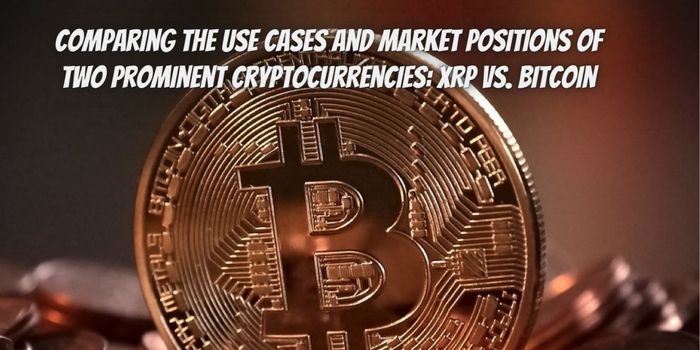Cryptocurrencies have taken the financial world by storm, revolutionizing the way we perceive and transact with money. Among the numerous digital currencies available, XRP and Bitcoin have emerged as two leading players in the market. In this article, we will delve into the key aspects of XRP and Bitcoin, comparing their use cases and market positions to gain a better understanding of their roles in the ever-evolving world of cryptocurrencies.
Profit Edge which is an online trading platform plays a significant role in the growing popularity and adoption of cryptocurrencies, including Bitcoin. Visit https://profitedge.org/ and get started on the official website.
Introduction to XRP
XRP, created by Ripple Labs, is a digital currency that aims to facilitate fast and low-cost international money transfers. Unlike Bitcoin, which operates on a decentralized blockchain, XRP utilizes a consensus algorithm known as the XRP Ledger. This algorithm enables quick transaction confirmation and high scalability, making XRP an efficient solution for cross-border payments.
One of the primary use cases of XRP is to act as a bridge currency in Ripple’s payment network, RippleNet. Financial institutions can leverage XRP as a liquidity tool to facilitate instant transfers between different fiat currencies. By eliminating the need for multiple intermediaries and pre-funded nostro accounts, XRP streamlines the settlement process, reducing costs and settlement times significantly.
The Rise of Bitcoin
Bitcoin, introduced in 2009 by an anonymous person or group known as Satoshi Nakamoto, is widely regarded as the pioneer of cryptocurrencies. As the first decentralized digital currency, Bitcoin operates on a peer-to-peer network called the blockchain. This technology ensures transparency, security, and immutability of transactions without the involvement of central authorities.
Bitcoin’s use cases extend beyond being a medium of exchange. It has emerged as a store of value and a hedge against traditional financial systems. With a limited supply capped at 21 million coins, Bitcoin’s scarcity has contributed to its value appreciation over time. Investors and enthusiasts view it as a digital equivalent to gold, seeking refuge from inflation and economic uncertainties.
You may like to know : Essential Skills and Knowledge to Develop for Bitcoin Trading
Comparing Use Cases
While both XRP and Bitcoin exist within the broader realm of cryptocurrencies, their use cases differ significantly. XRP primarily targets the realm of international remittances and cross-border payments, aiming to improve the efficiency and cost-effectiveness of these transactions. On the other hand, Bitcoin functions as a decentralized digital currency and store of value, offering an alternative financial system outside the control of centralized entities.
Moreover, XRP’s design enables it to bridge different fiat currencies, allowing for seamless transfers between traditional banking systems. Its focus on interoperability positions XRP as a facilitator of global financial integration. Bitcoin, on the other hand, emphasizes the decentralization of power and the democratization of money, empowering individuals to have full control over their funds without relying on intermediaries.
Market Positions and Adoption
When it comes to market positions, both XRP and Bitcoin have garnered significant attention and adoption, albeit in different contexts. XRP has witnessed widespread adoption by financial institutions seeking efficient cross-border payment solutions. Ripple’s partnerships with various banks and remittance providers have contributed to the increased utilization of XRP within the traditional financial sector.
Bitcoin, on the other hand, has gained popularity as a speculative asset and investment tool. Its decentralized nature and potential for substantial returns have attracted a diverse range of investors, including institutional players. Additionally, Bitcoin has seen increased acceptance as a form of payment in various online and offline establishments, further solidifying its position as a widely recognized cryptocurrency.
The Future Outlook
Predicting the future trajectory of any cryptocurrency is a challenging task, given the dynamic and rapidly evolving nature of the digital asset market. However, both XRP and Bitcoin are expected to continue playing significant roles in shaping the financial landscape.
As Ripple expands its network of partnerships and strives to revolutionize cross-border payments, XRP may witness increased adoption by financial institutions worldwide. Its speed, scalability, and cost-effectiveness could potentially disrupt traditional remittance systems, benefiting businesses and individuals alike.
Bitcoin, on the other hand, is likely to maintain its position as the most prominent cryptocurrency. Its store of value properties and increasing acceptance as a medium of exchange provide a strong foundation for its continued growth. As more institutions and individuals recognize the potential of Bitcoin as a hedge against inflation and a diversified investment asset, its market position is expected to strengthen further.
Conclusion
In conclusion, XRP and Bitcoin represent two leading cryptocurrencies with distinct use cases and market positions. While XRP focuses on improving cross-border payments through its efficient consensus algorithm and interoperability, Bitcoin has become synonymous with decentralized finance and a store of value.As the cryptocurrency market evolves, these two digital assets will continue to shape the future of finance in their respective domains. Whether it’s the facilitation of global remittances or the revolution of traditional financial systems, XRP and Bitcoin are at the forefront of innovation, driving the adoption and integration of cryptocurrencies into the mainstream. So, whether you’re a financial institution exploring efficient cross-border solutions or an individual seeking financial sovereignty, XRP and Bitcoin offer compelling use cases and market positions that are worth considering.




